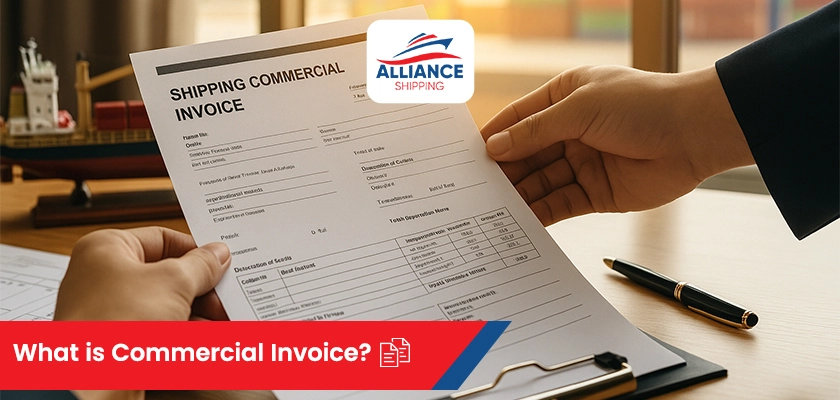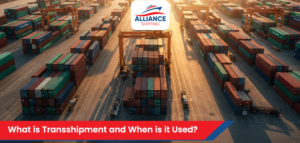A commercial invoice is a legal document used in the shipping industry. It serves as a contract and proof of sale between the seller (exporter) and the buyer (importer), but it is not usually the primary contract of sale. Customs authorities also check the commercial invoice and verify the contents and value of the shipment. Using this document, authorities calculate duties and taxes and confirm the consignment complies with import regulations.
There are many more things to learn and understand about the commercial invoices. In this detailed blog, Alliance Shipping discusses them all.
What is Commercial Invoice?
A commercial invoice is a multifunctional document used in international shipping globally. It provides detailed information about the goods being shipped, the exporter, the importer, and the declared value of the shipment. Customs authorities also use this document to verify the goods’ details and calculate the taxes and duties that would be payable upon import.
Purpose and Functions of a Commercial Invoice
Apart from customs authorities, the commercial invoice has various purposes and functions. Different parties use this document for their records, payment processing, shipment tracking, and verification of transaction details
- Sellers use the commercial invoice as a bill for the goods and as proof of the transaction.
- Buyers use it to verify the quantity, value, and description of the goods.
- Banks and logistics providers use this document for processing payments and handling documentation related to letters of credit.
It won’t be wrong to say that commercial invoices are one of the first documents needed in international trade, along with other documents like the bill of lading, certificate of origin, and packing list.
Customs authorities require a commercial invoice to process and clear the goods, as well as to calculate duties and taxes payable on the shipment. If there are any mistakes or missing information, the shipment can be delayed or even rejected at the border.
Who Issues a Commercial Invoice?
A commercial invoice is always issued by the seller. The seller here refers to the party that is selling the goods. This is because the document includes sales-related details such as product descriptions, quantities, prices, and payment terms.
All this information comes from the seller, who is directly involved in the sales agreement. Therefore, the issuance of the commercial invoice always comes from the seller. Another common question is who signs the commercial invoice?
There are usually two parties involved in the signing. One is obviously the seller. The second is the exporter, who may also sign the document if they are legally responsible for handling the export process.
For example, if a company is shipping grains overseas, the seller could be the grain mill that produces and sells them. The exporter, on the other hand, might be a logistics company or an export agent tasked with managing the shipment and export documentation on behalf of the seller.
The signature on the commercial invoice confirms that all details are accurate and complete to the best of the signatory’s knowledge. These details include the product description, quantity, value, and terms.
Risk of Shipping Without a Commercial Invoice
When you do not have a commercial invoice, it can cause serious problems during international shipping. Since customs authorities use this document to understand what’s being shipped and how much it’s worth, they won’t allow the goods to be cleared without it. This means your shipment can get stuck at the border, facing long delays and costing you extra storage charges.
In the worst-case scenario, customs may even reject or send the shipment back to the sender. Without a commercial invoice, taxes and duties can’t be calculated properly, and it becomes hard to prove the value or ownership of the goods.
It can also lead to disputes between the buyer and seller. So, missing this document can result in both financial loss and a damaged business relationship.
Sample Commercial Invoice Template
There is no fixed format or template for a commercial invoice, but it must include all the key details about the shipment. The goal is to give customs and carriers complete and clear information. As long as the document is accurate and complete, it can be in any layout or style.
Here’s what should be included, written in simple terms:
- From: Your name and address as the sender
- To: The name and address of the person or company receiving the package
- Intermediate Consignee: Details of any third party handling the package before the final delivery
- Date: The day the package is sent
- Invoice Number: Your own reference number for this invoice
- Customer PO No: The customer’s order or reference number
- Currency Used: The type of currency used in the invoice
- Country of Origin: The country where the goods were made or produced
- Reason for Export: Why you are sending the package
- B L AWB No: The shipping document number used by the carrier
- Final Destination: Where the package is going in the end
- Export Route or Carrier: The shipping company or route being used
- Terms of Sale: The agreed shipping terms, often listed as Incoterms
- Terms of Payment: The payment agreement between you and the buyer
- Terms of Freight: Shipping cost details, like who pays and how
- Number of Packages: How many boxes or packages are being sent
- Comments: Any extra notes about shipping or delivery
- Contents: What is inside the package
- HS Code: The customs code for the product
- Value: The price for each item
- Net Quantity: The total amount of products
- Weight KG: The full weight of the shipment
- Freight: Shipping cost if it applies
- Insurance: Cost of insurance, if included
- Date and Signature: Your name, signature, and the date you signed the invoice
Difference Between a Commercial Invoice and Other Documents
Now that you know what a commercial invoice is, there are a few other documents that people often confuse it with. For example, there’s the proforma invoice, packing list, and bill of lading.
See, the difference is that a commercial invoice is a legal document used for customs clearance and payment purposes. In contrast, a proforma invoice is simply a preliminary bill sent before the goods are shipped.
A packing list details the contents, quantities, and packaging of the shipment, and a bill of lading serves as a contract of carriage between the shipper and the carrier, as well as a receipt for the goods.
Each document has its own function. They might contain some of the same details, but they are all required under shipping regulations because each serves a different legal, logistical, or customs-related purpose. And together they ensure everything happens perfectly, from transportation to compliance, and the final delivery of goods.
Common Mistakes to Avoid When Filling Commercial Invoices
When you are filling out important documents such as commercial invoices, there are a few things you cannot afford to get wrong. Ideally, any information written incorrectly is a potential cause for delays, extra costs, or even shipment rejections. However, customs authorities pay special attention to certain key elements in a commercial invoice.
Whenever you are completing a commercial invoice, make sure you avoid these mistakes:
- Incomplete HS codes
- Incorrect currency codes
- Mismatched descriptions
- Forgetting to sign and date
- Wrong country of origin
The reason is that all these elements are critical for customs clearance and determining duties, taxes, and compliance. Getting them wrong could mean delayed shipments, financial penalties, or goods being held at the border until the errors are corrected.
Is your commercial invoice ready?
So, that’s all about commercial invoices. Once you follow all the points discussed in this blog, you’ll have a complete, ready-to-use commercial invoice.
Alliance Shipping is a leading shipping company in Dubai, UAE. Many shipping terms and documents can be complex, and it’s common for people to make mistakes when filling them out or to have limited knowledge about them. That’s why we started the Learn Logistics with Alliance series to help you better understand the basics of shipping, key documents, and important industry terms.
Feel free to reach out to our team for any queries you have. Contact us at:
For Call: +971566495103
For Mail: manager.dxb@theallianceshipping.com






















